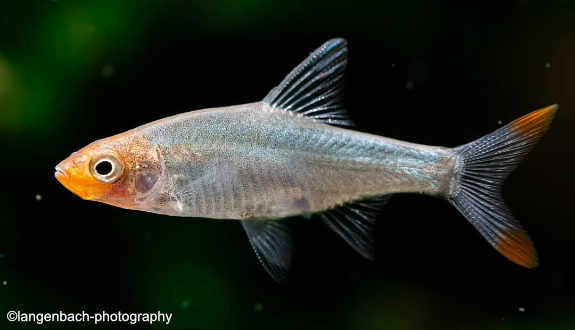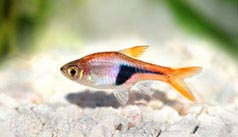

Alternative species (click on the thumbnail to see the card)
Names
Scientific name
Sawbwa resplendens
Common name
Sawbwa barb
Rummy nose rasbora
Asian rummynose
Naked microrasbora
Nacktlaube (DE)
Glühköpfchen (DE)
Origin

Origin: Burma (Inle Lake)
Biotope: Asian
Dimorphism
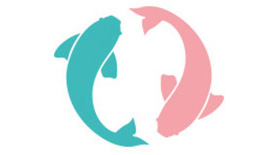
Very easy. The male has a red/orange head and two spots of the same color on the caudal fin
Group
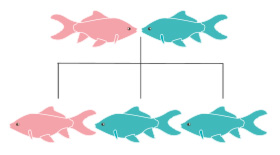
Cyprinidae
Volume

80 L / 18 imp gal / 21 US gal
Parameters

T°: 18 to 24°C or 64 to 75°F
pH: 7 to 7.2
Hardness: 15 to 20°dGH
Difficulty
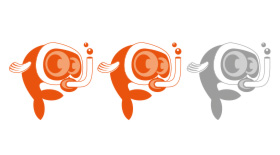
Average
Size

2 to 4cm (0.8 to 1.6")
Longevity

2 to 4 years
Living zone

Middle
Individuals

10
Food
How to feed the Sawbwa barb?
Food
How to feed the Sawbwa barb?
The Sawbwa is an omnivorous fish easy to feed: it accepts all forms of food. Vary your meals as often as possible, both in form (freeze-dried, frozen or live) and content (daphnia, artemia nauplia, ostracods...). Attention, food must be adapted to the size of his small mouth!
Behavior
What kind of behavior does the Sawbwa barb have?
Behavior
What kind of behavior does the Sawbwa barb have?
This very good swimmer is quite lively yet peaceful. There is also a fearful character (it is generally best observed when you are a few distances from the aquarium). The males are sometimes aggressive with each other to the point of establishing a hierarchy.
Its swimming is jerky, it is in fact an advantage in its natural environment, with a very cluttered decor.
Cohabitation
Who can live with the Sawbwa barb?
Cohabitation
Who can live with the Sawbwa barb?
Gregarious and sociable, he needs the presence of his peers to feel good. Maintain a group of at least 10 individuals, which will form a nice shoal. Note the aggressiveness of the males among themselves, that's why you need an aquarium big enough despite their size (count at least 60 cm / 24" of front). To constitute your group, plan 4/5 females for each male (these fish live in harem naturally).
For the other species, no major problem to report. Preferably choose calm fish. Avoid large species that could hunt and eat Swabwa.
Beware of cohabitation with freshwater shrimp such as Neocaridina. Indeed, it will leave the large shrimp alone but will attack all the juveniles.
Breeding
How to breed the Sawbwa barb?
Breeding
How to breed the Sawbwa barb?
You will need a specific aquarium, prepared with the same water as the community aquarium. Install a leaf of a broadleaf plant (Echinodorus amazonicus for example) as the Sawbwa deposit their eggs under the leaves, and some java moss (or Mop). On the population side, you will need 2 males and 1 female. The recommended water parameters are a temperature below 25°C or 77°F and a high hardness (15°dGH).
Isolate the group and stimulate spawning by feeding plenty of live prey. Also make good water changes for a few days. The fish that are about to spawn are unusually restless and then it is time for the parade. Finally, the spawning will last 2 to 3 hours.
The fish stick the eggs under the large leaf. Once the laying is done (check daily because the eggs are small), remove the adults quickly because they eat their eggs. Egg laying consists of about 30 eggs and incubation takes 3 days. It will take another 3 days for the fry to swim freely. Even though there are only a few eggs laid per clutch, they are fairly regular (up to once every four days).
Another protocol (useful to save as many fry as possible at each laying) is to allow spawning to take place in the community aquarium, and to take the sheet with the eggs stuck on it and put it in the rearing tank. Be careful during this operation because the eggs must not come out of the water!
The difficulty of reproduction is to find females!
The final colors (and therefore the sexing that goes with it) are only visible after 4 months.
Fry feeding: parameciums, vinegar eels for 5-6 days, micro worms and finally artemia nauplias from the twelfth day. Distribute several small meals per day.
Its aquarium
Which aquarium for the Sawbwa barb?
Its aquarium
Which aquarium for the Sawbwa barb?
This fish likes well planted aquariums but with plenty of space to swim. It also appreciates a rather dark environment. The lighting should therefore be dimmed, for example by using floating plants such as Limnobium, Pistias, Salvina, Ceratopteris... For the bottom of the aquarium, choose a dark floor. Such an environment also offers the advantage of bringing out the colors of the fish.
On the filtration side, a light current not too strong will be appreciated.
Heating is not mandatory if the aquarium is located in a temperate room since the Sawbwa resplendens appreciates a rather fresh water (ideally around 22°C or 72°F).
This species can be installed in a Lowtech aquarium or even in No-tech (sand, plants, wood, lighting or daylight).
Good To know
Find all additional information!
Good To know
Find all additional information!
This fish is really unique and amazing: it has no scales!
Quite fragile, the Swabwa is sensitive to chemicals and to variations in water parameters, that's why it is recommended to have a little experience in aquarium keeping before attempting to maintain it. Also be careful with the landing net, to be handled with care and as little as possible since the fish has no scales.
Beware of confusion with the Firehead Tetra (Hemigrammus bleheri), whose needs in water parameters are very different! Fortunately, the two species are easily distinguishable.
Unfortunately, the availability of this species is quite rare in trade, especially for females that are less colorful. Too bad when you think that you need significantly more females than males...
Threatened in its natural environment (IUCN Status: EN = Endangered), make sure that the fish you plan to acquire are indeed farmed, and not caught in the wild!
Yours photos!
Comments
Sort by:
Please login to post comments
